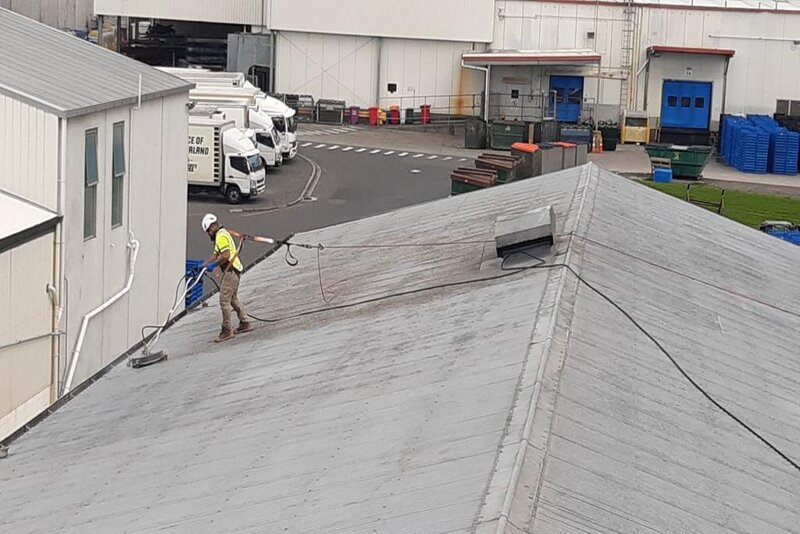Body harness safety systems are essential for the fall arrest system and serve two functions. The first is to evenly distribute any force from a fall throughout the body, and the second is to allow freedom of movement to perform a task. Worksafe shows that 50% of falls are from less than three meters and estimates the cost of falls in the workplace to be $24 million year-on-year.
It is vital to have an effective and complete understanding of how to use a body harness safely.
But what are the dos and don’ts of harness safety while working at heights?

How we manage body harness safety
We are fully trained and experienced in working at heights and in those hard-to-reach places. This enables us to remove pesky moss, mould, fungus, and grime. We also ensure that every staff member working at heights is NZQA qualified and carries their own health and safety kits.
These kits, provided by our team, include high-visibility vests, hard hats, certified regulation harnesses, first aid kits, and all necessary safety equipment.
We pride ourselves on the comprehensive body harness safety training we provide our staff. Upskilling staff in this field is vitally important, and harness safety courses help keep employees up-to-date. It outlines several key components required to be competent in safely using harness systems while cleaning at heights. These components are the cornerstone of our own harness safety practice.
Understanding the key components of safety harnesses and associated equipment
As mentioned above, training staff to have an up-to-date understanding of body harness safety systems is essential. Gripping the components of a harness (excuse the pun) is the first step. What are fixed and adjustable length lanyards, retracting and twin-tail lanyards, carabiners, slings, and ropes?
Once this is understood, it’s important to comprehend the multitude of harness systems that can be used. You can have a static line and anchorage system, a fall restraint system, and a work positioning system. The list goes on.
Understanding the correct fitting and adjustment sequence is integral. This is to deliver evenness on the shoulders of the harnessed staff member and ensure that straps are untwisted and tightened to a comfortable ‘flat hand space’ level. Then check for any objects in the pockets to ensure nothing is hazardous and that the lanyard is secure.

The importance of double-checking and maintaining your body harness safety equipment
It is vital to understand what it means to undergo a pre-check and double-check all safety equipment. This practice should be second nature and conducted long before you hit the roof to begin industrial cleaning.
Our staff is trained to recognize the minute details of damage to harnesses and connectors. They must understand how this can result in traumatic injury if not properly maintained and monitored at all times.
Is the attachment point secure?
Are the shoulder straps frayed in any way?
Are the fall arrest attachment points entirely in place?
It is critically important to complete a functional assessment and multiple visual inspections of the harness connection and length before staff begin cleaning at heights.

What is a rescue plan in the event of a fall?
Part of any good body harness safety system is ensuring a solid rescue plan. This must be in place in the unlikely event of a fall. Although we pride ourselves on ensuring safety is at the forefront, it is essential to have a rescue plan should it ever need to be enacted. Ensure that the roles of the rescue plan are crystal clear to every staff member involved on the job.
We are proud to foster a team environment among our industrial cleaning employees and believe solid teamwork can also help minimise the risks of working at heights. Having a range of two or more people working together on these projects can provide greater confidence and support.

What is a PREQUAL certification?
These prestigious certifications were created by some of New Zealand’s top health and safety experts.
PREQUAL certification was started in 2011 and is now one of the leading standards measuring health and safety practices across the country.
It has been bench-marked against both international best practices and local experience.
We are proudly PREQUAL certified, demonstrating that our safety protocols have been independently assessed and verified by those involved in this initiative.
It also means we aim to drive continued growth and improvement of health and safety procedures in our business.
No matter the industry or the task at hand, our team of highly trained professionals, renowned for their dedication to safety, will complete every job with the highest level of safety in mind. This is our way of doing business – delivering excellence every step of the way!
We embrace projects of all sizes. There’s no challenge too big or small for us. With our comprehensive range of services, we will do what others can’t or won’t do.
Contact us now for a complimentary, no-obligation quote tailored to assess your unique requirements and experience the Rapid difference!

